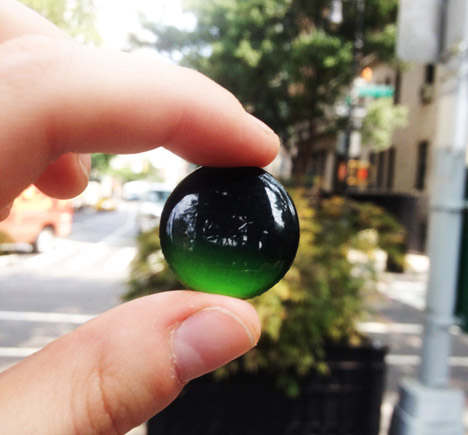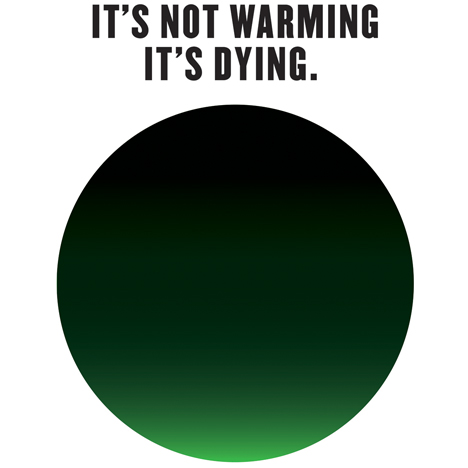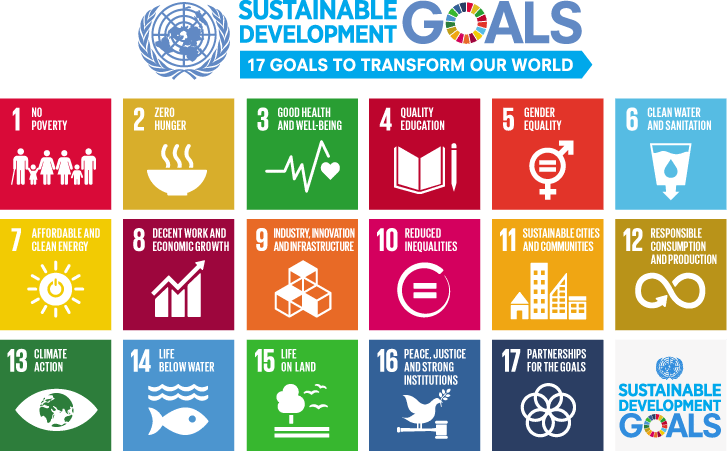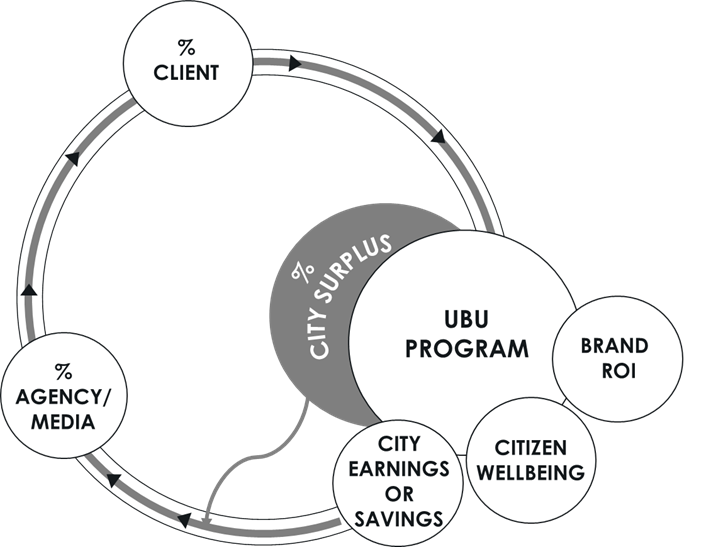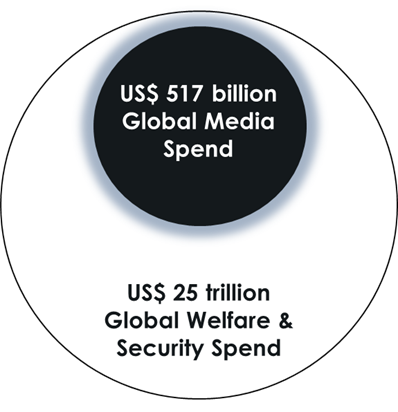Urban Brand-Utility: a protopia for marketing communications that is both effective and regenerative
Share

This is part one of a two-part article.
Marketing and advertising activity has, on one hand, greatly contributed to economic development, generation of jobs, innovation and market efficiencies, as well as greater access to culture and entertainment. On the other hand, it has polluted cities, annoyed consumers and jeopardised its own existence from the constant interruption in people’s attention with little perceived value to provide in exchange. From a societal perspective, our global media and advertising footprint also comes with a hefty toll.
In the UK, advertising is responsible for two million tonnes of CO2 emissions annually, equivalent to heating 50 percent of London’s social housing. The findings came from CarbonTrack™, the world’s first credible, universal tool designed to calculate the carbon footprint of an advertising campaign throughout its entire life cycle. This is a superb measurement tool, but we are still missing the management piece so metrics can represent more than just statistics.
When considering the management of brands and the incredible rise in the valuation of intangible assets, it is not surprising that the idea of brand purpose has been the chief response to our zeitgeist. Still, the approach – despite of its best intentions – has not been able to fully replace other fiscal instruments (e.g. taxes) and effectively make brands play a more meaningful role to ensure a greener, more equitable and more harmonious society.
Even the promotion of climate action is as questionable as the promotion of anything else. For example, Milton Glaser, creator of the seminal ‘I♥NY’ logo and one of the most celebrated graphic designers in the world, came up with a logo for climate change in 2014. In an awareness effort, Glaser’s logo was amplified through billboards (around New York City), collectible buttons and some other merchandise. Despite its clear emotional appeal, the logo could not effectively be translated into action. In fact, its carbon footprint alone may have justified its abandonment.
The same applies to the more commercial advertising attempts at jumping on the sustainability ‘brandwagon’. To encourage people to buy its electric vehicle ‘Zoe’, Renault deployed a digital billboard connected to pollution sensors created to give price discounts corresponding to levels of pollution at any given time of day. Clever communications undoubtedly, but does it solve the issue of air pollution?
Colin Mayer, professor of Management Studies at the Saїd Business School at the University of Oxford, along with the British Academy, has been leading the ongoing Future of the Corporation research project, aimed at understanding how business may be able to solve the problems it has created. In Mayer’s view, it begins with redefining the very purpose of business to “produce profitable solutions to the problems of people and planet, and, in the process, it produces profits”.
Mayer’s view brings a much sharper focus to the loftiness of brand purpose. It does not reduce the importance of profit to generate prosperity, but ensures the utility of a higher-order mission. Interestingly, ‘effective altruism’, a new philosophical idea, has recently emerged with the exact purpose of addressing the lack of rigour and the confusion between what we feel is good with what is effectively good.
Yet, with so much to address and with such a powerful arsenal of marketing tools to deploy, how may we find a shared focus able to deliver as much impact to as many people as possible, while still delivering on the kingly ROI?
An alternative and desirable outlook to widening the role of marketing
Although cities only occupy two percent of the Earth’s landmass, they are where 75 percent of resource consumption and most brand communications are concentrated. Further, the United Nations has projected that, by 2050, about 64 percent of the developing world, and 86 percent of the developed world, will be urbanised. That is equivalent to approximately three billion metropolitan residents by that date. Even when considering the UN’s Sustainable Development Goals (SDGs), urbanisation is the megatrend seemingly underpinning all others.
Due to increased demand for ever more comfortable lifestyles, the existing urban infrastructures have been feeling their ‘growing pains’ for decades now. From energy to education, health, waste management or safety, cities’ services are struggling to keep up with their larger, older and ‘hungrier’ populations. This is an important insight for marketers, where UN Sustainable Goal 11 ‘Sustainable Cities and Communities’ becomes the key to countering the narrowness that marketing has acquired over the last decade.
As important as it is to reduce the number of clicks on a consumer journey, marketers need to understand what people are really interested in. A way for brands to become a more integral part of people’s urban life-journeys is to address issues like: reducing violence in the streets, pollution, unemployment or enhancing opportunities for entertainment, human connections and so much more.
[quote style=’1′ cite=”]Such logic can turn advertising into a regenerative force for cities, where the promotion of goods and services is not only more profitable, but also environmentally enriching and socially virtuous . Markets, choice and competition are not just a consumer’s best friend, but their political representation. Brands with some level of foresight are able to broaden audiences from customers to citizens, and revenue models from sales to the creation of shared value. These transformations will be the game-changers driving our industry forward.[/quote]
To do good, we must also do well. Advertising is the soul of the capitalist system and the best incentive to upgrading it is by generating surpluses. For example, in Moscow, Sberbank was approached by major Russian real estate developers to collaborate on better infrastructure planning in residential areas. People’s opinions on local needs powered targeted campaigns, promoting loans for small businesses. The Neighbourhoods campaign generated nine times as many small business responses than traditional loan advertising.
In other words, people are having their needs addressed with neighbourhoods becoming more attractive and safer. The city increases tax collection from the new businesses being set up, which also reduces the cost related to having to deal with derelict areas. For the biggest Russian bank, caring about citizens is not just a nice thing to do, but also an effective way for Sberbank to positively impact its bottom line.
Urban Brand-Utility: a regenerative protopia to invigorate our industry narrative
The idea of a ‘circular economy’ was first raised by British environmental economists David W Pearce and R Kerry Turner in 1989. In Economics of Natural Resources and the Environment, they pointed out that a traditional open-ended economy was developed with no built-in tendency to recycle, which was reflected by treating the environment as a waste reservoir.
Since then, many approaches to transform our linear ‘take, make, dispose’ economy into one that turns waste into new resources have been tested. According to research from the Norwegian University of Science and Technology, only around 20 percent of emissions for which we are responsible come from direct usage, such as driving cars or running showers. The rest is all hidden in the supply chains of what we buy. In the marketing supply chain, products can now be conceived in ways that eliminate waste and obsolescence (e.g. Cradle-to-Cradle™), while places and people can be magnified through platform strategies and technologies, but what about the fourth and most notable ‘Marketing P’, that of promotion?
Rather than just minimising externalities, how may we maximise the benefit that brand touch points can deliver beyond transactional messages? According to Emma Forster, Smart City projects officer for City of Melbourne, “If brands need to think outside the box, cities need to think beyond the grid.”
Within this series of tensions Urban Brand-Utility (UBU) was born. Just like the idea of a circular economy, where products and services go beyond an end user’s finite life cycle, UBU looks at brand communications as closed loops by designing a system bigger than fixed campaign periods, target audiences and business as usual KPIs. As a ‘marketing protopia*’, UBU aims to reframe brand communications as a catalyst for sustainable development via public-private-people partnerships and radically innovative use of media through the adoption of three core objectives:
- enable savings or new earnings for cities
- create urban shared value to the cities’ inhabitants, and
- deliver superior return on brand objectives.
Here’s a hypothetical situation. Let’s assume that Sberbank’s Neighbourhoods campaign is turned into a bigger initiative, generating a large surplus to the city of Moscow by minimising the costs from dealing with unemployment, dereliction, vandalism and lower tax collection. Rather than treating this as a one-off campaign, smart mayors would try and create a virtuous cycle. In this thought experiment, 50 percent of the surplus is retained by the city, 25 percent is returned to the advertiser and 25 percent to the agency and media owner – a value unlocked only by repeating the approach.
The more advertisers communicate their messages in a way that benefits brand, people and city, the cheaper it becomes to do more of it. The more cities encourage such an approach, the faster societal problems would be addressed. In other words, UBU’s circular revenue model enables the creation of shared value by enhancing, instead of interrupting, people’s moments, turning marketing budgets into investment funds, as shown on the model below:
[quote style=’1′ cite=”]In this more useful and integrated new world, agencies and their clients would partner with cities and media owners via open data, matching brands with specific urban challenges and forming the foundations of a network of creative, urban resiliency.[/quote]
CMayors and citizen-consumers can help grow the pie
Demonstrations of how the private sector can – through their brand communications – creatively fix what big government is failing to address, and make a profit, have not yet reached a tipping point, but isolated cases keep emerging. Domino’s Pizza is one of those brands that looked beyond the traditional path-to-purchase to permeate people’s life-journeys.
Aware that potholes, cracks and bumps in the road can cause irreversible damage to people’s pizzas during the drive home, Domino’s decided to pave towns across the US to save their customers’ pizzas from the bad roads. Obviously, not only Domino’s customers are benefited from this effort, but those using and maintaining the newly paved roads and, of course, the intangible value of the brand.
This may sound silly but, according to the National Surface Transportation Policy and Revenue Study Commission of the US Congress, the annual investment required by all levels of government to simply maintain the US’s highways, roads and bridges is now estimated to be US$185 billion per year for the next 50 years. Today, the nation annually invests about US$68 billion.
Mayors and city managers from the municipalities where ‘paving for pizza’ has taken place have acknowledged the creation of shared value. In this sense, a new breed of mayors with a marketing mind, or CMayors (CMO plus mayor), are equally empowered to driving the UBU vision.
According to Bill Scherer, Mayor of Bartonville in Texas, “This unique, innovative partnership allowed the town of Bartonville to accomplish more potholes repairs.”
The city manager of Milford in Delaware, Eric Norenberg, said, “We appreciated the extra Paving for Pizza funds to stretch our street repair budget as we addressed more potholes than usual.”
Much more is required to create a reliable network of creative, urban resiliency. But, according to the 2015 World Economic Forum’s Global Agenda Council on the Future of Cities, “Cities will always need large infrastructure projects, but sometimes small-scale infrastructure can also have a big impact on an urban area.”
As such, UBU can be operationalised by following six strategic imperatives:
- Translate the big idea that defines your brand into a big utility that can deliver its impact.
- Replace interruptive interactions with enhancing ones by delivering a public utility service.
- Turn any existing utility of a communications effort from a stunt into a sustained practice.
- Shift your business focus from short-term sales results to longer-term profitability and prosperity.
- Broaden your audiences from customers to citizens, expanding paths-to-purchase onto life journeys.
- Diversify revenue from sales to the creation of shared value and surpluses.
By considering advertising media as not only communication channels, but channels that can deliver public utility services, we can grow the size of the media spend pie and, by extension, the size and influence of the marketing, advertising, media, communications and creative industries.
As a comparison, in 2020 global media spend in brand communications accounted for almost US$517 billion, an almost 12 percent decline (due to COVID-19) when compared with 2019. Parallel to that, investment in Smart City infrastructure has amounted to US$124 billion, representing an increase of 18.9 percent over 2019 spending. When putting one next to the other, what we see is a 4:1 ratio, approximately. This means that for every dollar spent to improve our cities mobility, energy systems, safety, culture and entertainment, quality of air, water and so much more, four dollars are spent to sell us more stuff.
Through the UBU approach, the current US$517 billion spend could be increased by another US$25 trillion, which represents the much larger pie of global welfare and security spend, a figure obtained by dividing 2020’s Gross World Product (GWP) by the 30 percent global average spent on welfare and security as per the International Monetary Fund (IMF).
The above provides a plausible scenario for advertisers to become key players in public-private-partnerships to completely reinvent the industry and transform society for the better. [quote style=’1′ cite=”]Even though we cannot shop our way into sustainability, citizen-consumers are important players to enabling business to tackle the issues that matter most. [/quote]Where and how we spend our money does matter. But how much it matters depends on what else we do with our money and what governments and corporations do with their (considerably larger) pots. The big problem, though, is that individual monetary action – even when performed collectively – is only the beginning and, perhaps, an expensive distraction from the real work at hand.
The Consumer Citizen, a book by political scientist Ethan Porter, makes a provocative claim: “The conventional idea of citizenship is a fantasy, and the only language the vast majority of people understand is consumerism.” If that’s true, then we need a new mechanism that accepts this reality and tries to leverage it to produce the best possible outcomes. Whereas individual product swaps will do little to nothing to impact legislation and corporate responsibility, could it be different if not only products, but the media promoting those, is repurposed? That’s UBU’s big bet.
Authors:
 |
Sérgio Brodsky is the executive producer of Futurecast and a leading brand and foresight strategist. |
 |
Jo Whyte is the Head of the Marketing and Communications at TAC. |
 |
Puruesh Chaudhary is a futures researcher and strategic narrative professional and the founder and President of AGAHI. |
Cover Artwork:
Original illustration and artwork by Rafael Medeiros.


